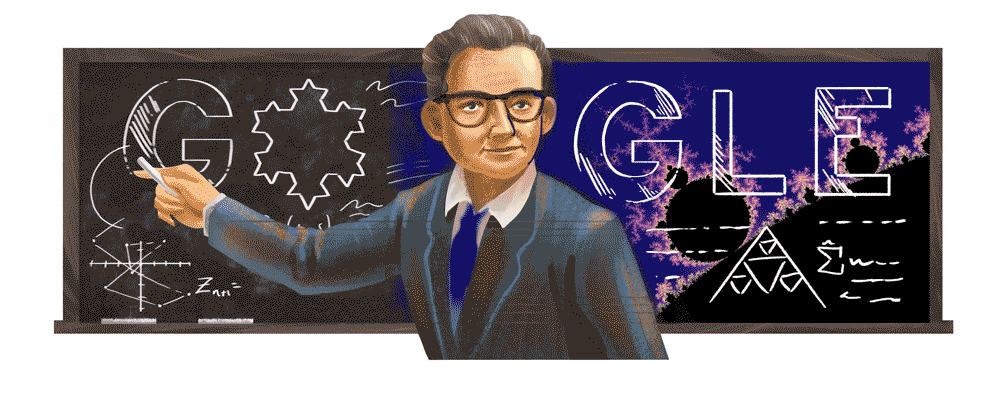
Benoit Mandelbrot is the mathematician and father of fractal geometry who is honored in the November 20 Google Doodle. Mandlebrot, a native of Warsaw, Poland, is also the namesake of the Mandelbrot set. The doodle coincides with what would have been Mandelbrot’s 96th birthday. At the time of his death in 2010, Mandelbrot was both a citizen of the United States and of France.
Mandelbrot’s work would resonate in areas as varied as medicine, finance, physics and geometry.
According to Google’s blog on Mandelbrot, he experienced a non-typical education in his youth. Prior to World War II breaking out in September 1939, Mandelbrot’s family moved to France, settling in the town of Tulle south of Paris in 1936 when Mandelbrot was 11 years old. He was homeschooled by his Paris-based uncle, Szolem Mandelbrojt. The pair spent most of their time playing chess together.
The New York Times reported in 2010 that Mandlebrot was born into a Lithuanian Jewish family. According to the Times, after moving to France, Mandelbrot worked in fixing tools and looked after horses.
Here’s what you need to know:
1. Mandelbrot Married His Wife Aliette Kagan in Switzerland in 1955

Mandelbrot studied mathematical sciences in college, eventually achieving a PhD in the subject. Mandelbrot earned a master’s degree in aeronautics from the California Institute of Technology and also studied at the Institute for Advanced Study in Princeton, New Jersey. In 1955, while working as a professor at the University of Lille, Mandelbrot married Aliette Kagan in Geneva, Switzerland. The couple would remain married until his death, according to The Guardian’s obituary.
In 1958, Mandelbrot went to work for IBM at the Watson Research Center in Yorktown Heights, New York in 1958. Mandelbrot’s use of IBM’s latest computer technology led him to arguably his most famous work. Mandelbrot told Wired in a 1994 interview that he never used a computer at IBM during his first years with the technology giant. In part, because the technology did not yet exist to do Mandelbrot’s theories justice. He said, “I pushed my friends to develop special, makeshift, and bad devices so I could transform my geometric dreams. Before that, people did not believe my hand drawings. Once a computer gives you output, it’s credible.”
2. Mandelbrot Coined the Phrase Fractals in 1975
In 1975, Mandelbrot coined the phrase fractals. Fractals are geometric shapes that repeat infinitely the closer you look at them. The November 20 Google Doodle shows Mandelbrot standing in front of a chalkboard while discussing fractals. The first O in Google is replaced with the Koch snowflake. The Koch snowflake is considered one of the first fractals going back to 1904 before the word fractal was invented. The doodle includes a fractal viewer where users can zoom in and out of a Mandelbrot set.
Mandelbrot set his ideas forth in his 1967 essay How Long Is the Coast of Britain? and the 1982 book The Fractal Geometry of Nature. Mandelbrot told The New York Times in 2010, “Here is a question, a staple of grade-school geometry that, if you think about it, is impossible. The length of the coastline, in a sense, is infinite.” According to Google, Mandelbrot remained working at IBM for 35 years becoming an IBM Fellow and Fellow Emeritus.
3. Mandelbrot Became Yale’s Oldest Tenured Professor in 1999
Mandelbrot took his work to Yale University in 1987 when he accepted a position as mathematics professor. In 1999, Mandelbrot became the school’s oldest tenured professor, according to The New York Times. Following his time at Yale, Mandelbrot also accepted a position as the Professor of the Practice of Mathematics at Harvard University and Professor of Mathematics at the École Polytechnique.
A few months before his death in 2010, Mandelbrot spoke at length about fractals during a TED talk. During his talk, Mandelbrot also spoke about “the art of roughness.” According to The Daily Telegraph’s 2010 obituary for Mandelbrot, “Before Mandelbrot, mathematicians believed that most of the patterns of nature were far too complex, irregular, fragmented and amorphous to be described mathematically.” The tribute describes Mandelbrot’s work as becoming “the foundation of Chaos theory.”
While at IBM, Mandelbrot also applied his study of electronic noise that interfered with the company’s computers to financial markets. Mandelbrot noticed similar repeating patterns in financial markets after studying cotton prices. The Daily Telegraph noted in their obituary that Mandelbrot predicted a global financial meltdown in 2004 owing to bankers behaving like “mariners who heed no weather warnings.” The New York Times described Mandlebrot as having a “reputation as an outsider to the mathematical establishment” in their obituary.
4. Mandelbrot Succumbed to Pancreatic Cancer in Cambridge, Massachusetts, in 2010
At the time of his death, Mandelbrot was survived by his wife Aliette Kagan and his two sons, Didier and Laurent. He had been suffering from pancreatic cancer and passed away in a hospice in Cambridge, Massachusetts, Kagan told The New York Times in 2010. Laurent Mandelbrot is the Professor of Medicine at the University of Paris-Diderot, a role he has been in since 2002.
Mandlebrot’s son, Didier, is quoted on Google’s blog about the doodle as saying that his father’s life was “driven by curiosity.” Dr. Didier Mandelbrot spoke about his father’s great memory and how he “played with ideas.” He said his father could comfortably converse with brilliant scientists and school children alike. Didier Mandelbrot said, “Benoit was a rare person who looked more broadly and by this, saw more deeply.”
5. Mandelbrot Believed it Was Technology’s Role to Aid the Human Eye
Among the honors bestowed upon Mandelbrot include the 1993 Wolf Prize for physics and having an asteroid, 27500 Mandelbrot, named for him. His work inspired the Artur C. Clarke book The Colors of Infinity: The Beauty, and the Sense of Fractals and the Jonathan Coulton song, “Mandelbrot Set.” Mandelbrot was also featured in the 1995 British documentary The Colors of Infinity. Mandelbrot said in the film, via The Guardian:
For me the first step with any difficult mathematical problem was to programme it, and see what it looked like. We started programming Julia sets of all kinds. It was extraordinarily great fun! And in particular, at one point, we became interested in the Julia set of the simplest possible transformation: Z goes to Z squared plus C [where C is a constant number.
So Z times Z plus C, and then the outcome of that becomes a new Z while C stays the same, to give new Z times new Z plus C, and so on]. I made many pictures of it. The first ones were very rough. But the very rough pictures were not the answer. Each rough picture asked a question. So I made another picture, another picture. And after a few weeks we had this very strong, overwhelming impression that this was a kind of big bear we had encountered.
During his 1994 interview with Wired, Mandelbrot spoke of the influence that Plato had on his work. Mandelbrot said, “The influence of Plato is extraordinarily strong. Plato was a tremendously brilliant mind, but as a mathematician, he was nobody. Plato believed that the sentiments, the eye, the feeling for formula, and geometric aspects were just bad in mathematics.” Mandelbrot went on to say that technology’s role is to aid the human eye saying, “The eye must use any help it can get from microscopes, telescopes, infrared instruments, and now the computer.”
READ NEXT: Former Fans Want TikTok Star Canceled Over ‘Racist’ Video – Watch it Here